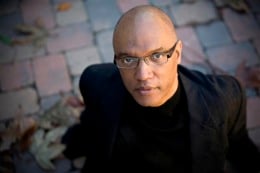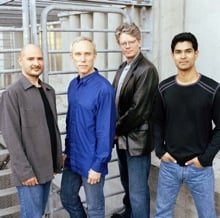
Musical genres are concepts that may be crawling toward extinction in the new millennium, or so pianist Billy Childs believes. Looking to a more integrated era, he’s positioning his jazz quartet alongside the classically trained Kronos Quartet for the premiere of his commissioned composition, on Sept. 18 on the Jimmy Lyons Stage at the Monterey Jazz Festival.
“When you listen to jazz nowadays, it’s very composed, a lot of it,” points out Childs, who began recording for the Windham Hill Jazz label in 1988. “And, more and more, classical musicians are interested in improvisation. There is a desire for the two to connect.”
“In terms of improvising off chord changes, that’s not something we do much of,” Kronos’ violinist and Artistic Director David Harrington admits. But when Childs asked him what he’d be comfortable with at Monterey, he responded, “Total freak-outs and notated modules that we’ll improvise from.” He remarks that, “Recently, we’ve been doing quite a lot of improvising from drones, while playing with Alim Qasimov,” the quartet’s Azerbaijani vocal collaborator on Rainbow, its latest outing on the Smithsonian Folkways label.

The Monterey Jazz Festival, about to celebrate its 53rd annual installment, was already inviting classical crossover back when the festival was birthed by former radio deejay Jimmy Lyons and San Francisco Chronicle jazz and pop critic Ralph J. Gleason. On that Sunday afternoon in 1958, the festival showcased several proponents of what French horn player and composer Gunther Schuller had a year earlier dubbed “Third Stream,” a confluence of classical and jazz music that, in Schuller’s view, “were totally antithetical and antagonistic to each other.”
Schuller himself presented his Symphony for Brass and Percussion the following year. That program also showcased his friend John Lewis’ Modern Jazz Quartet, whose cool and well-dressed performance style was helping usher jazz, along with its African-American performers, into concert halls.
Young Childs Moves Through Genres
Listen to the Music
Chatting by phone from his Los Angeles residence, Childs recalls how his father, Joseph, raised him on recordings by the MJQ and the Swingle Singers, who took a playful, pop approach to the classics. “Then, when I was at an impressionable age in the early ’70s, what was going on was a meeting of classical with jazz, jazz with rock, and classical with rock,” he recounts. “This attempt to connect with other genres in an organic way was very influential.” In 1975, Childs began studies at the University of Southern California with Robert Linn, a composer of orchestral and chamber music.
He went on to build a career with solo recordings on jazz labels and collaborations with such jazz luminaries as Freddie Hubbard, Chick Corea, and Dianne Reeves. Yet classical influences have became more and more apparent in Childs’ work, leading, during the last decade, to commissions from the Los Angeles Philharmonic and two volumes of recorded music on the artistShare label. The second, this year’s Guggenheim-funded Autumn: In Moving Pictures, involves the classical Ying Quartet in what the composer himself calls a “Jazz-Chamber” context.
“My concept was to create really beautiful melodies that invite you in, and I figured that when you do that, you can become as complex as you want, as layered as you want,” Childs explains. “It just felt natural to make the music more impressionistic.” He was eager to go beyond a jazz ensemble, “because if I just did piano-bass-drums-trumpet-and-sax, I wouldn’t have as many options, colorwise, as I do with a harp, guitar, and string quartet. When I want to describe things like a scenario in autumn, I need more colors.”
Like Childs, Harrington has long strived to broaden his palette, and he was already dipping into jazz as a Seattle teen. “My composition teacher, Ted Benshoof, would play pieces of [visionary jazz pianist] Thelonious Monk for me, and talk about his timing,” Harrington reminisces, a few days after Kronos’ return from this summer’s tour of Europe. “And one of the great recordings I remember hearing in high school, which totally changed my life, was Bessie Smith and Louis Armstrong, and a harmonium player whose name I can’t remember [Fred Longshaw], doing The St. Louis Blues [in 1925]. They talk about Mozart being classic? This was classic! It can’t be more perfect or more refined than that.”
Shortly after Kronos moved from Seattle to San Francisco, in 1978, jazz bassist Charles Mingus, in the last year of his life, mailed the Quartet a piece he'd written for it. That work hasn't yet been transposed from its setting for three cellos, but Kronos has performed Mingus’ The Children’s Hour of Dreams, and recorded a tribute to Monk for Landmark in 1985, with jazz legend Ron Carter guesting on bass. Later, free-jazz visionary Ornette Coleman wrote a quintet for Kronos, “and the thing we learned from Ornette, in rehearsals, was the idea that something is not necessarily ‘together’ just ’cause it starts at the same time. For him, ‘together’ might be, if you look up and there’s a flock of birds flying over: They’re together. It had to do more with the intent than with the Western idea that there’s this line, and anything which is not on that line isn’t ‘together.’ And what a tone that man gets! To me it’s like a great violist who happens to play saxophone.”
Jazz Goes Long-Form
More recently, Harrington was introduced to the evocative long-form compositions of Big Band leader Maria Schneider, and, realizing that “she has this incredible vision,” he commissioned her String Quartet No. 1, which Kronos premiered at Duke University in April. “She’s used to conducting, and we’re not used to being conducted,” says Harrington about rehearsals for this piece. “But I think she was really inspired to learn about our bows and what they can do, different kinds of techniques and sounds, and ways you can phrase.” Schneider was also delighted to discover that her late mentor and sometime employer, Gil Evans (who's famously arranged for Miles Davis), had proposed composing for Kronos.
The first movement of Schneider’s new work “was particularly challenging for us, because the beat is shared among all four parts, so you can get off-track really easily,” says Harrington. “When you have a dedicated [jazz] rhythm section, you don’t have to worry about it as much.” Kronos will perform the Schneider quartet at Monterey this year, at the Festival’s Night Club venue, later in the evening of the Childs premiere.
It was Monterey’s general manager, Tim Jackson, who suggested that Childs seek out Kronos. “Tim is a great visionary promoter of the arts,” testifies Childs, “because he consistently tries what Bill Graham used to do: to book different things with different other things, trying to enhance art.” Harrington responded by listening to Childs’ recorded oeuvre, of which he says, “I think he’s kind of in touch with an area of musical language that will be very good for Kronos to move into. He’s writing a form of chamber music, and picking up on the notated tradition that comes from Haydn and Beethoven and on into Bartók and Berg, and later some of the other people who have written for us.”
Harrington confides that he hopes “to create a unified field theory of music,” and that he expects his time at Monterey to enhance his theorizing, as well as his pleasure. “My impression is that there’s music all day and all night there. And I don’t feel good if I don’t have many hours for exploration each day. … This morning, for example, I was talking with Steve Reich about WTC 9/11, his next string quartet for us. And another conversation today was with Judith Berkson, a cantor who has a new album [Oylam] out on ECM, a jazz label. She sent me a set of songs, and one of them just blew me away. It’s called The Raven, and it turns out it’s by Schubert! She totally changed the song; it was life-altering. So what do you call her album?” Of genre segregation, he advises, “There’s no barbed wire fences that surround our ears and don’t let music in.”
